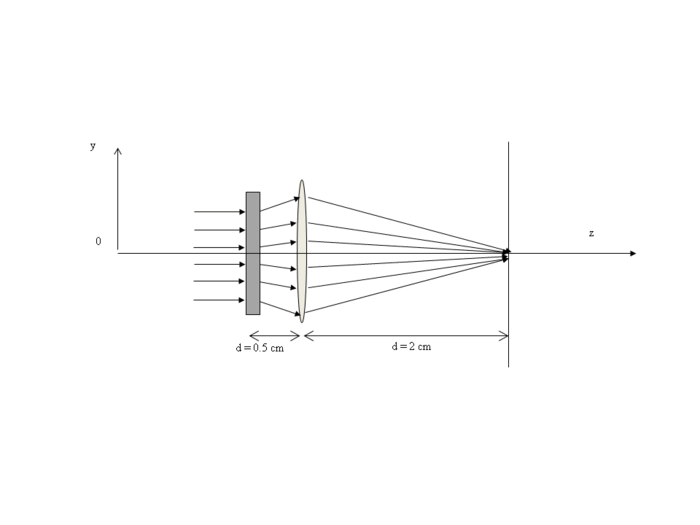Difference between revisions of "Problem Set 1"
(→Question 3) |
(→Question 3) |
||
| Line 38: | Line 38: | ||
Consider the two-lens system shown in the figure below, where the rectangle on the left represents an unspecified lens of focal length <i>f<sub>1</sub></i> separated by 0.5 cm from another lens with focal length of 1cm. Find the value of <i>f</i> such that all the rays incident parallel on this system will be focused at the observation plane. | Consider the two-lens system shown in the figure below, where the rectangle on the left represents an unspecified lens of focal length <i>f<sub>1</sub></i> separated by 0.5 cm from another lens with focal length of 1cm. Find the value of <i>f</i> such that all the rays incident parallel on this system will be focused at the observation plane. | ||
| − | + | [[Image:Corrective Lenses.gif|700px|center]]<br/> | |
<references /> | <references /> | ||
</div> | </div> | ||
Revision as of 15:42, 4 February 2009
Question 1
For this question, you will need to stop by the lab and make a few measurements of lenses. The whole thing should take about twenty minutes.
- Measure the focal lengths of the lenses marked A, B, and C
- Turn on the halogen lamp.
- Move the screen to produce a focused image.
- Measure the distance d1 from the imaging target to the 75mm lens, the distance d2 from the lens to the screen, and the height H of a feature on the image.
- Repeat this measurement for several values of d1
Part a
- What is your estimate of the focal lengths of lenses A, B, and C?
Part b
- What is the relationship between d1, d2, and H? Make a plot of your measurements that shows this relationship.
Question 2
In lab, you are going to build a microscope. As discussed in lecture, a single lens can act as a magnifier. (You have certainly used a magnifying glass to look at something small.) But all modern microscopes that achieve very high magnifications use multiple lenses in series to make an image. This is clearly a much more expensive design. Why not use a single lens as a high-magnification microscope?
- List three potential problems with a single-lens, high-magnification microscope design. Explain the problems in few sentences and a simple sketch.
HINT: Use the information about the behavior of light in that was presented in lecture. Think about the underlying assumptions of geometric optics. Under what circumstances in a real microscope design would each assumption be violated? How do these violations impact the final image? (If you are stuck, go back to the lecture slides and take a close, logical look at each assumption. Where does each assumption break down? What is the effect of this breakdown in the assumption?)
Extra credit
For each problem you identify with a single-lens, high-magnification microscope design, explain in a sentence or two and a brief sketch how multiple lenses might ameliorate the problem.
Question 3
Consider the two-lens system shown in the figure below, where the rectangle on the left represents an unspecified lens of focal length f1 separated by 0.5 cm from another lens with focal length of 1cm. Find the value of f such that all the rays incident parallel on this system will be focused at the observation plane.
